Win in Writing: Copywriting Shortcuts to Accelerate Enterprise Deals
The enterprise rep who can write will outsell the one who can’t, 10 out of 10 times.
Becoming a better writer, therefore, is becoming a better seller. With every memo you draft and narrative you craft, you’re adding a few points to your win rate.
However, writing remains the #1 skills gap for enterprise sellers. Too many sales reps still see themselves as more “conversational” than “creative.”
It’s a view rooted in a false dichotomy lingering in the go-to-market world. The B2B equivalent of that extended relative who won’t leave your house after dinner's over. It says sellers are talkers, while marketers are writers. And it’s a dangerous belief.
The reality is every enterprise rep either is, or needs to become, a writer.
Buyers debate their problems and priorities — and decide who to partner with — during internal meetings. Not sales meetings. Which means sales reps won’t be in the room to shape their message when it truly matters most.
Your writing can be, though.
If we’re on the same "page" there, you’re wanting to become a better writer. (i.e. seller)
Here’s how: a series of copywriting shortcuts. A kickstart to feel creative, fast, so you’re more likely to keep on writing. Which, in turn, will kickoff the write-win-write-win feedback loop.
The more you write, the more you win, so the more you write. And so on until you’re retired.
Turning Bad Writing Good
Here’s your first shortcut: write with contrast.
Showoff the before and after because contrast creates clarity, and your goal is always clarity.
So let’s use the contrast between good and bad writing to showcase a few more shortcuts:
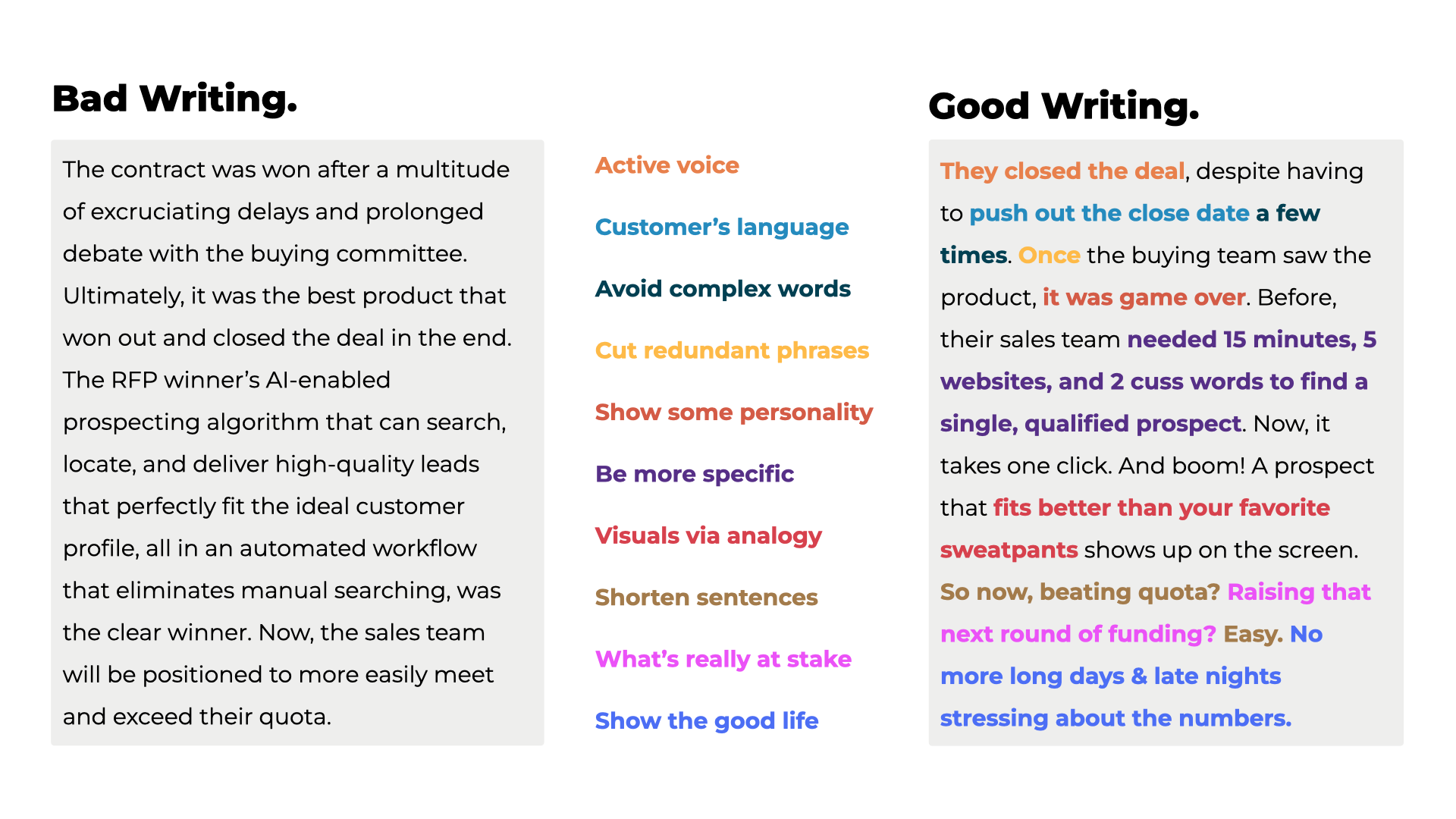
The second paragraph is clearly better. But why? What changed exactly?
Here's a line-by-line breakdown from the visual.
1/ Replace passive with active voice.
- The deal was closed —> They closed the deal.
2/ Use your customer’s language.
- Multitude of delays —> Pushed the close date.
3/ Simplify your word choice.
- “Excruciating” and “prolonged” —> cut these.
4/ Cut redundant phrases.
- “Ultimately,” and “in the end.”
- “Won out,” and “closed the deal.”
5/ Dial up the pain.
- Before: AI-enabled prospecting algorithm that can search, locate, and deliver...
- After: Their sales team needed 15 minutes, 5 websites, and 2 cuss words...
6/ Create a visual using analogies.
- Before: High-quality leads that perfectly fit the ideal customer profile.
- After: Fits better than your favorite pair of sweatpants.
7/ Shorten your sentences.
- Before: All in an automated workflow that eliminates manual searching...
- After: Now, it takes one click.
8/ Show some personality.
- Before: It was the best product that won out.
- After: Game over for the competition.
9/ Show what’s really at stake.
- Before: More easily meet and exceed quota.
- After: Raising that next round of funding? Easy.
10/ Showcase the good life:
- “No more long days and late nights stressing about the numbers.”
The “after” version isn’t perfect. It can still use a little love. But it’s good enough for an example.
Now, it’s your turn. Take this paragraph and try re-writing it using the shortcuts above.
The spreadsheet software is introducing a new timeline view that it says will provide a clearer and more intuitive perspective on how your work is progressing, and provide project management tools within the platform for the first time.
The new view is a visual layer that displays project information stored in Sheets, such as the task start and end date, description, and owner. Users can also view more information about the project in the sidebar by clicking on a card within the timeline, and also track progress over time by accessing updated versions of the timeline at various time intervals (day, week, month, quarters, year, and multiyear).
- Source
Alright. Feeling warmed up?
Let’s keep rolling with some extra writing tips then.

1/ Lead with the truth.
Good writing starts by confirming what your buyer already believes is true. The headline on Lattice’s website is an excellent example:
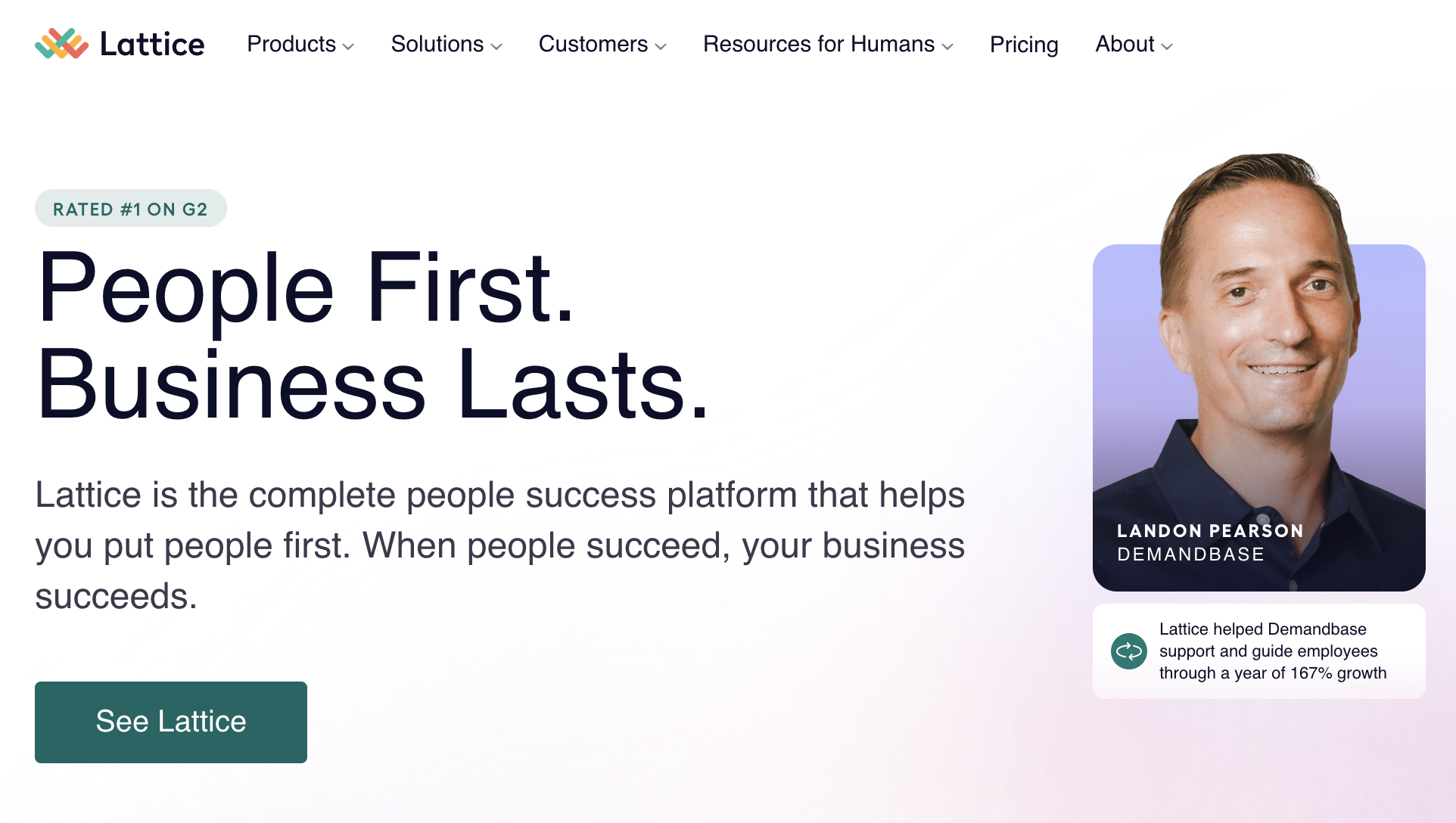
Lattice sells to people teams. Naturally, they believe people are the bedrock of successful businesses.
I’m also a fan of introducing non-obvious insights to challenge conventional beliefs. It’s a good approach. And you should use it. But it’s the sequencing that’s important here.
Challenging a closed mind is a dead-end. Establishing common ground by leading with something you both believe creates an open mind, and works within confirmation bias.
2/ Obsess over your headlines.
Here’s how the copywriting legend David Ogilvy describes the value of a good headline:
On average, fives times as many people read the headline as the body copy. When you have written your headline, you have spent 80 cents out of your dollar. If you haven’t done some selling in your headline, you’ve wasted 80 percent of your money.
For example, you’re only reading this sentence because you decided to read past the first sentence. Which (if I may say so) was pretty decent:
The enterprise rep who can write will outsell the one who can’t, 10 out of 10 times.
Write and re-write your first sentence until your reader can’t help but continue on.
3/ Rephrase and repeat a single truth.
Good writing travels around the enterprise. Just the same, bad writing is a plane that can’t liftoff because there’s too much weighing it down.
Strip your message down to the single truth your reader needs to understand and share. Then, say it in a few different ways. Here’s an example of three phrases, all repeating Fluint’s one truth:
- Stop losing deals when you’re not in the room.
- Over 90% of B2B buying happens without sales reps in the room.
- Shape the internal buying conversations happening about you, without you.
4/ Choose your framing wisely.
If you’re shopping for a new car, a Rolls Royce is one of the most expensive cars you can buy. But next to a yacht, private jet, or rare work of art, it looks cheap as h*ll.
When asked about it, Rolls-Royce’s Regional Director Peter-Paul Schoppmann says they don’t have competitors in the auto industry. Instead, they compete with art, boats, and real estate.
That’s why Rolls Royce frames their cars as unique works of art. Something you “commission.” Not something you “configure.” (You don’t configure art.)
Compare the language Rolls Royce uses to frame their cars, vs. BMW or Bentley (both of which also put themselves in the luxury car category).
Rolls Royce:
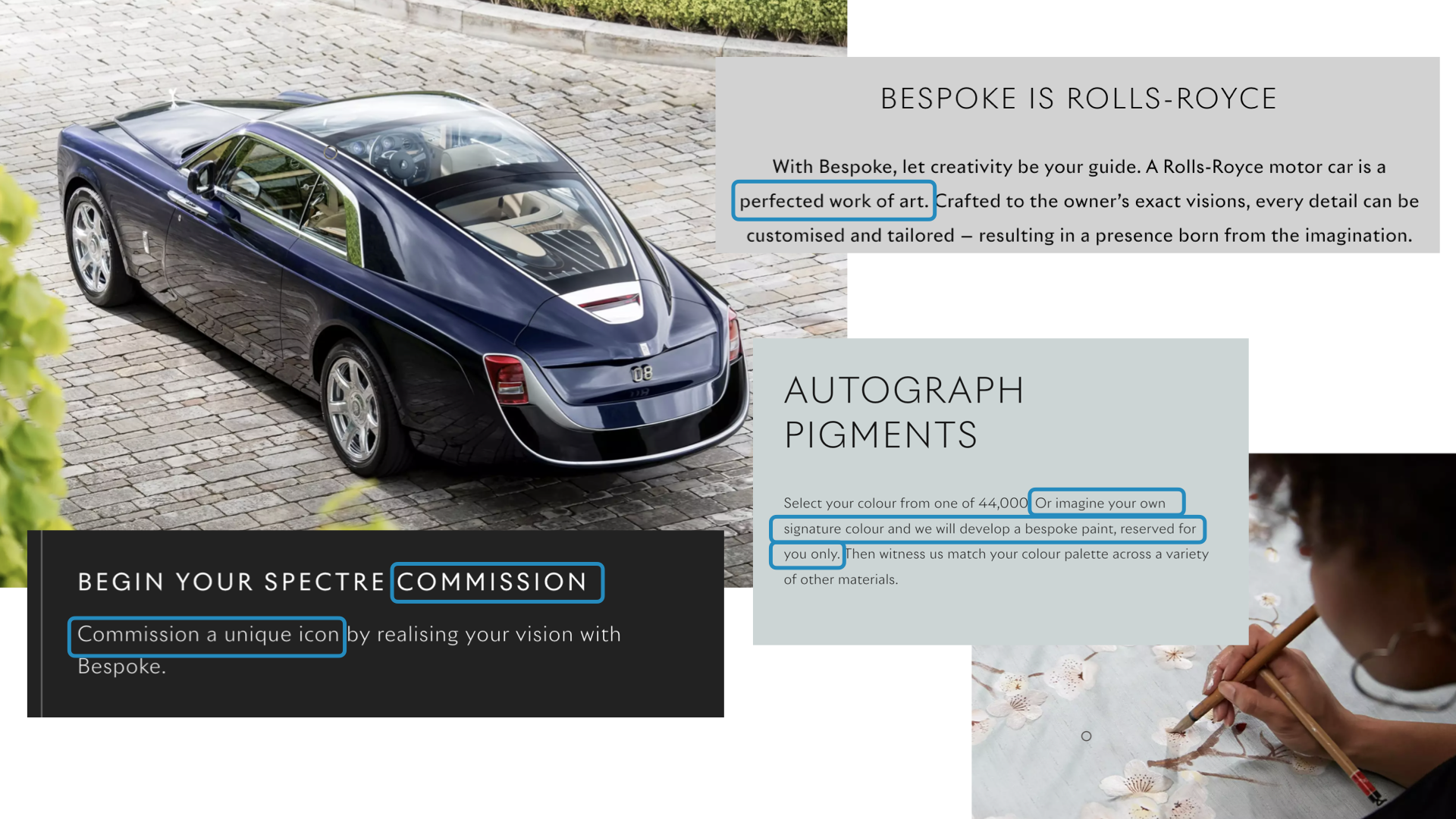
vs. Bentley:

vs. BMW:
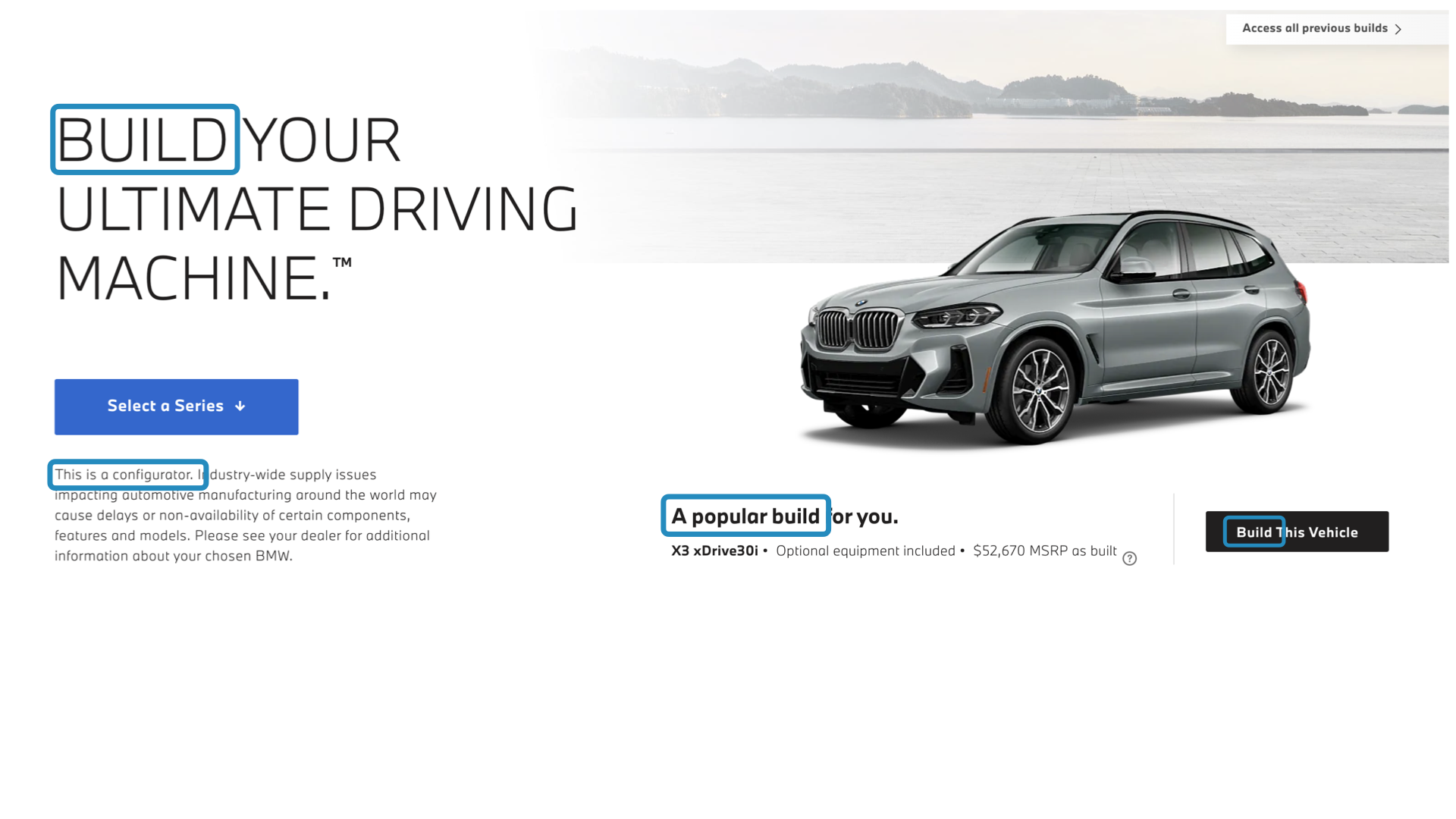
When you use this writing shortcut, there are two approaches:
- Switching the Frame:
See above. This is the Rolls Royce approach.
- Negative Framing:
See below. Switching from a benefit to a loss-oriented message.
With a negative frame, you’re sharing the exact same facts. But with the opposite emotional charge. Here are two examples:
- B2B: “Switching payroll providers will save you $30,000 per year” —> “If you don’t switch payroll providers, you’ll waste $30,000 in unnecessary spend this year.”
- B2C: "The competition's yogurt is 90% fat-free.” —> “Gross. 10% of that yogurt is all fat.”
5/ Sprinkle these phrases into your writing.
Good writing has “flow.” It seamlessly transitions the reader from one line to the next.
If you’re writing something longer than a paragraph, sprinkle these phrases into your content. Then, adjust the end of the prior sentence, or the start of the next, to create better flow.
- At last.
- Announcing:
- Finally,
- You guessed it.
- Should… not…
- That’s right.
- Because
- If… then.
- Why?
- “Quote”
- Get the… without the…
For example, Webflow might tailor the, “Get the… without the…” and, “Should… not…” phrases from their home page for a specific account’s reality. Then add it into their sales materials.
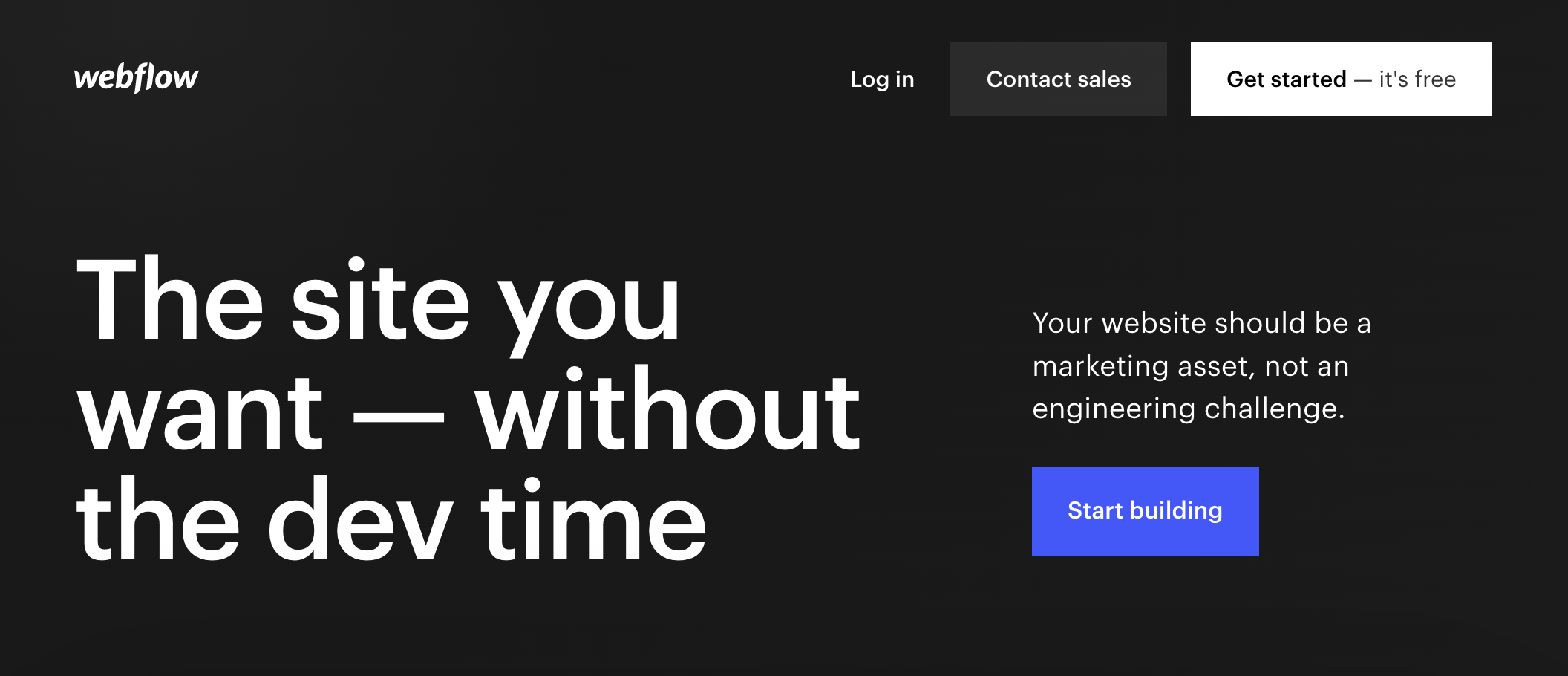
Let’s say Webflow's talking to a new products division inside of Nike.
The Nike team needs to quickly launch, test, and learn about new product lines, independent of their corporate site and approvals timeline. So Webflow might write:
The product site you need — without all the red tape.
(Followed by content on goals for new products launched and market share captured.)
Then:
Your website should be a research tool, not an approvals nightmare.
(Followed by content on establishing a process for quickly securing customer feedback.)
6/ Use vivid verbs.
Look at the last tip. “Sprinkle” sounds more interesting than, “Add these phrases.” Doesn’t it?
The reason is when you spice up your verbs, you’re tapping into emotion. You’re nudging your message in the right direction on the Logical <—> Emotional continuum.
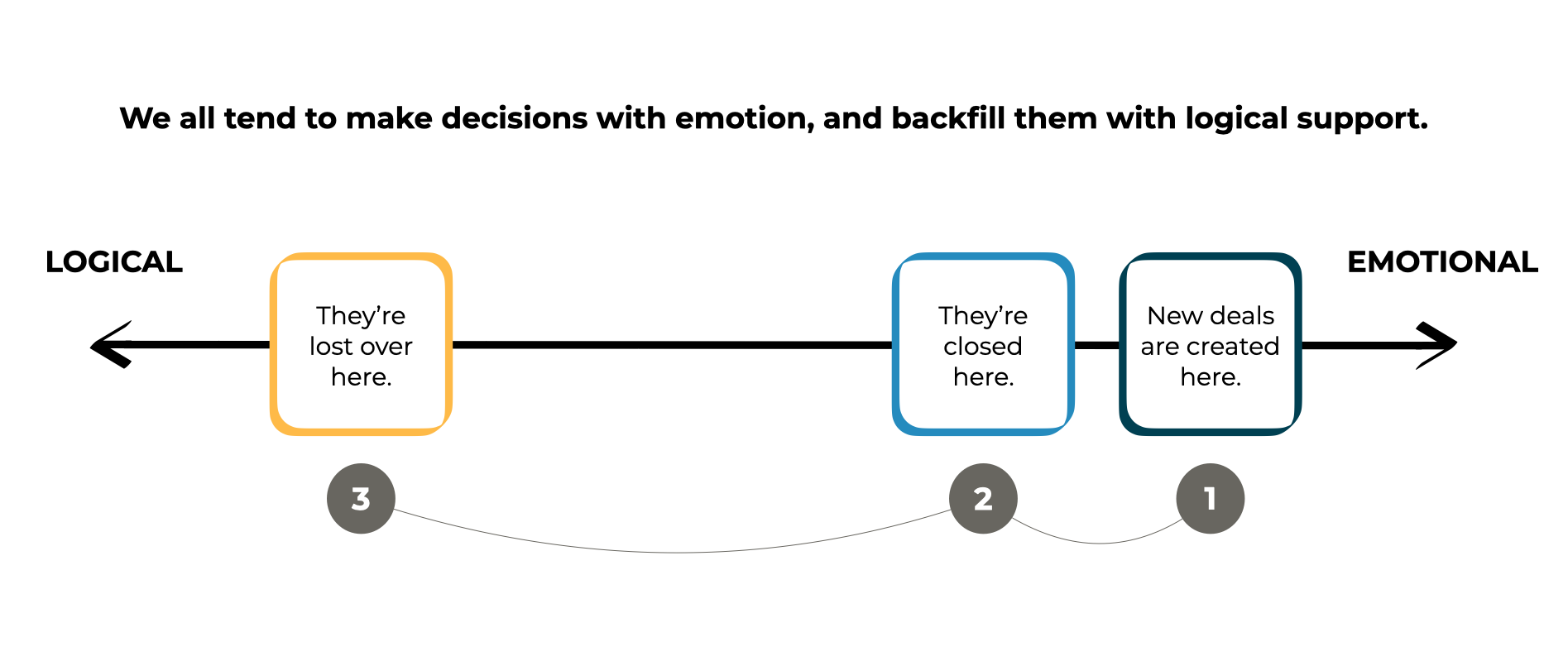
Remember, people make decisions emotionally, then justify it with facts, after the fact.
7/ Address common objections upfront.
Every seller knows which objections are inevitable. It's always just a matter of time before they're raised. The sooner you can address these in your writing, the more attention you'll earn.
Otherwise, unresolved objections create mental blockers, distracting readers like a bad stain:
8/ Write to a single person.
A classic writing sickness, whose symptoms are jargon and buzzwords, is writing for “an audience.” Investing legend Warren Buffett has the medicine: writing to a specific person.
Here’s the point he makes:
When writing Berkshire Hathaway’s annual report, I pretend that I’m talking to my sisters. I have no trouble picturing them: Though highly intelligent, they are not experts in accounting or finance. They will understand plain English, but jargon may puzzle them. My goal is simply to give them the information I would wish them to supply me if our positions were reversed. To succeed, I don’t need to be Shakespeare; I must, though, have a sincere desire to inform. No siblings to write to? Borrow mine: Just begin with “Dear Doris and Bertie.”
The one spin I’ll throw on this is, sometimes, it’s best to write to one person in your specific audience. Not Warren Buffett’s sisters.
For example, the Economist knows who its readers are:

9/ Use your buyer’s own words.
Trust and connection are both key to winning a complex sale. “Coordinating language” is a fancy term for talking like a group you’re part of, to build trust fast.
When you use the same words and sentence structure as the others you’re around, it’s a powerful shortcut that signals, “I understand you. You’re safe here. We’re from the same tribe.”
Which turns writing into an exercise that’s more like “assembling.” You’re adding your buyer’s own words from conversations into a framework. Like that old game, Mad Libs.
10/ Make it a matter of identity
This one's a subtle miss. It’s common because at first, you seem to be in the "good writing" category. You quantified a problem, pointed out the cost of status quo, but…
…the company’s loss wasn’t tied to the way a contact sees themself. The Heath Brothers write in their book Switch:
Because identities are central to the way people make decisions, any change effort that violates someone’s identity is likely doomed to failure…
So the question is this: How can you make your change a matter of identity rather than a matter of consequences?
The keywords here are change and identity. Change, what every closed deal creates, is successful when it’s part of us. Not just our companies.
Understanding and framing a messaging around identity is how you tap internal urgency. Which already exists inside your buyers, and is far more compelling than external urgency.
You see this all the time in consumer brands, by the way.
For example, Volvo’s messaging of “no deaths or serious injury in our cars.” That message turns their auto engineers into guardians. Consumers into caring, concerned parents looking out for their kids. Another classic example is Lego:

Here, they're taking their messaging three levels deep:
- Features. "Here's what it is."
- Benefits. "Here's what it does for you."
- Identity. "Here's who you'll become."
11/ Lastly, you can’t multitask. So stop trying.
Multitasking is a myth. I’m sure you’ve discovered this by now.
If I’m typing out a text, I may be aware that my wife is talking. But I’m not actually hearing what she’s saying. No matter how hard I try to fake it. And if I try talking to her about our dinner plans, I’ll end up typing “Greek food” into my text.
It’s the same idea with your writing:
- When you’re drafting, draft.
Just get your thoughts onto the page, no matter how ugly it looks.
- When you’re editing, edit.
Start by restructuring your content. Put the bottom line up front. Make sure there’s a logical flow. Then make a second round of edits to clean up grammar, structure, and so on.
Drafting is about creativity. Editing is about clarity. If you try to get both of these benefits at once, you end up with neither.
Why stop now?
You’re on a roll. Keep reading related write-up’s:
Draft with one click, go from DIY, to done-with-you AI
Get an executive-ready business case in seconds, built with your buyer's words and our AI.

Meet the sellers simplifying complex deals
Loved by top performers from 500+ companies with over $250M in closed-won revenue, across 19,900 deals managed with Fluint

Now getting more call transcripts into the tool so I can do more of that 1-click goodness.



The buying team literally skipped entire steps in the decision process after seeing our champion lay out the value for them.


Which is what Fluint lets me do: enable my champions, by making it easy for them to sell what matters to them and impacts their role.






.png)


